Last year, I began my journey with Structured Word Inquiry (SWI). I blogged about why I was interested in SWI for my professional growth project, as well as, a snippet into some of my lessons with last year’s Grade 2 class.
With school closures last year, I was unable to fully complete the prototype protocol with my colleague, Melissa Thompson. So naturally, I decided to pick this prototype back up and use it for my professional growth project again this year.
We started this year by looking at vowels. I pieced together some resources that were shared by our Director of Special Education, Sharon Reichstein, to create this vowel slide deck.
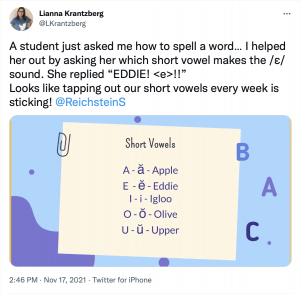
It has been amazing to see my students use their vowel hand, vowel partners, and tapping out short vowels when writing in their journals.
Through my own research for this professional growth project, I found a 2-session course all about Structured Word Inquiry with the one an only Pete Bowers! He started his first session with a story about being a Science teacher and what he said really resonated with me…
“There is a difference between teaching about Science and doing Science” (Bowers, 2021)
I might have been on track with this last year when I shared:
“At this point in my research, I feel as though the word investigations should be organic and student driven.”
…However, while the content we were investigating may have been student driven and organic last year, I do believe that much of the teaching and learning was falling under the umbrella of ”teaching about’ rather than ‘doing’. I have shifted my mindset away from thinking that SWI is a spelling program or resource that I can just teach in my classroom. Will SWI help my students become better spellers? Absolutely; but it is not a program or unit I can just roll out. It is a way of teaching, exploring, and most importantly, DOING. It will look different in every class.
This year, I am making a change.
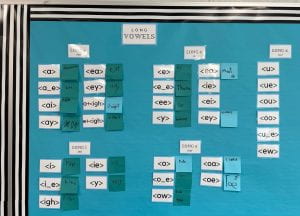
Together, we have been exploring our long vowels and building a bulletin board with the different ways to make the different long vowel sounds. I present the long vowel sound we are focusing on. Then the students must think of a word with that long vowel sound AND identify what it is in the word that is making that vowel sound. They are truly the ones doing the doing. This has led us to some deep conversations and investigations into digraphs that make more than one sound. For example, <ea> can be long ē like in meat, but also it can be long ā like in great.
Through our investigations in our vowel lessons, as well as, simply writing in English during Math, Science, and Journal time, we have started a list of things that we are wondering about! Last week’s big wonder was “Why is there an <e> in take but no <e> in taking?”.
This is where I introduced the power of word sums.
I started by writing what we already knew on the board; take+ing –> taking (let’s just pretend all of my equal signs are arrows). Then I continued by asking students to share more words that we could add the suffix -ing to.

This led us to look at some other suffixes (i.e. -ed) in words like baked (bake+ed –> baked). I asked the class to look at the board and tell me what they noticed. I was very proud when two of my students shared the following…
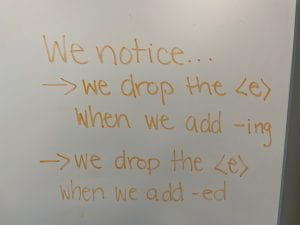
I asked if we could think of a rule that we could always follow to help us remember this. That’s when a student JUMPED up and said “You can’t have an <e> before a suffix”. I asked the class if we could challenge his idea and prove him wrong. If we can’t prove him wrong then we will add that rule to our wall, and if we do prove him wrong, maybe we will learn something new!
We looked at a suffix that is somewhat new to us; -ly (it is not used nearly as much as -ing and -ed).
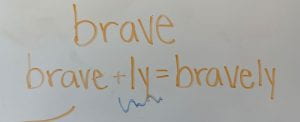
This is where the gears started to turn even even more! Look at that single silent <e> NOT being dropped in the word bravely when we add the suffix -ly!!
At first glance, another student JUMPED up and shared….

BUT then, with another moment to look at all the words we had collected on the board already, another student (the student who asked the question last week) was so excited to share that he figured out the rule…
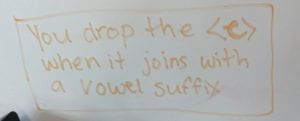
Proud is an understatement. My heart was bursting with pride and excitement as I watched my students investigate this suffixing convention. It was an incredible full circle moment to have the original student who asked the question last week, answer his own question today!
In my session with Pete Bowers, I understood the power of doing. In class today, I experienced the power of doing… and it was incredible.
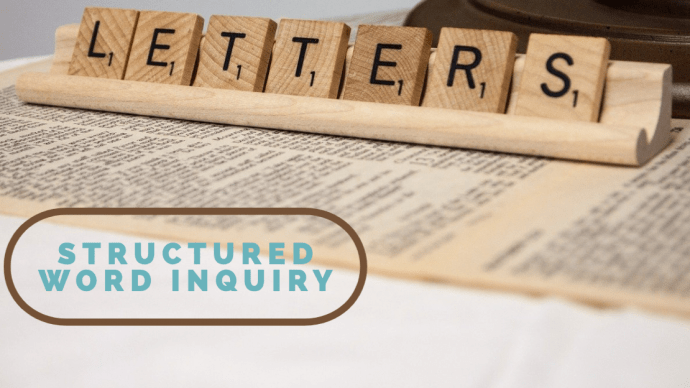
What a wonderful blog to share. I can hear the excitement in your writing. I can only imagine the learning energy in class as this investigative work was happening. Well done Kitah Bet! You definately follow our star – we learn better together.
I’m so proud of you!! It’s the best feeling ever when the student becomes the teacher. I clearly remember the excitement of my first year teaching SWI! It’s changed my life as I see it’s changing yours. Keep it up!!